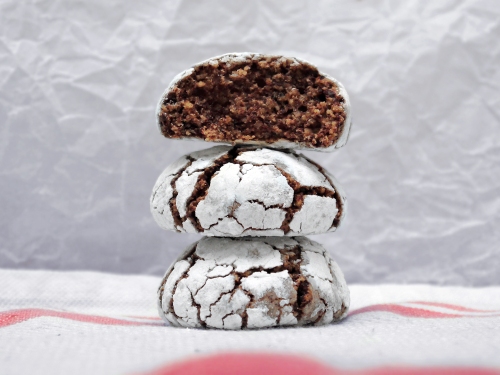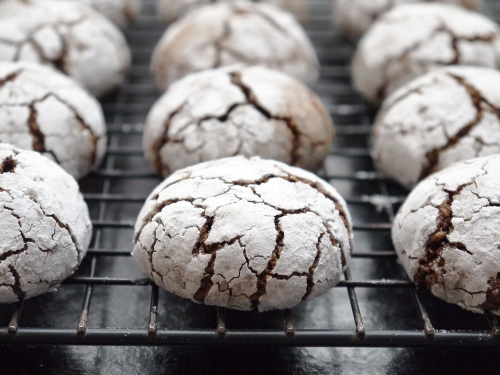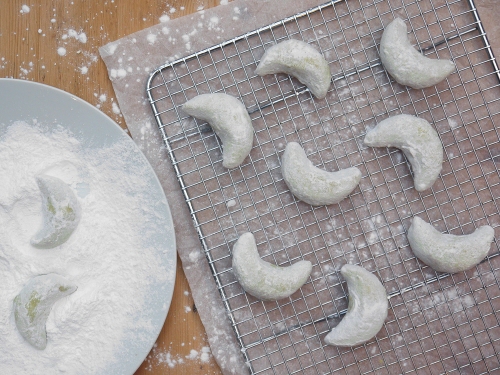We’ve already had one culinary jaunt to Austria this year with our pumpkin seed crescent cookies, and we’re going back for our penultimate recipe: Bauernbrötchen which translates as “farmers rolls”. But plain and rustic little breads these certainly are not!

At first glance, these seem to be chocolate crinkle cookies. They look like they contain chocolate, they are white and have that distinctive cracked appearance. Have I just made some of those and called them Austrian?
Of course not! But maybe these are their ancestors from the old country? I did look to see if I could find out more about how these cookies got their name, but drew a blank. My first guess was that it is something to do with the fact they use a lot of nuts, and that nuts were prevalent on farms. Of course this theory fall down quickly – the recipe uses a lot of chocolate, which is historically a luxury ingredient. My second guess, which seems more likely, is that they have more than a passing resemblance to large loaves of Austrian rye bread which is coated in flour with decorative cuts. Which theory do you think is right? It’s got the be the second, right?
Anyway, the method and ingredients for making these is very different from crinkle cookies. They are made mostly with ground nuts and grated dark chocolate, with just a little flour to hold everything together. So in my book, that makes them even better than crinkle cookies. They are rich but also substantial and taste very, very festive. They also skip spices or citrus flavours, so provide something different on a holiday cookie plate too. I also really like the random cracked appearance which is a real contrast to perfectly identical cookies.

For the nuts, I have used walnuts. These seem to be common in many recipes, and in my mind this is also a very Austrian ingredient. It features in Austrian baking, but there is also a giant walnut tree growing in the garden of the parents of an Austrian friend down near the Slovenian border. So in my head, they make a lot of stuff with walnuts there, and that was what I would do.
However, you can make some adjustments if you want (or depending on what you have to hand). Almonds, hazelnuts, cashews or pecans would all make fine substitutes, either on their own or in combination. I would steer clear of pistachios and pine nuts simply because their flavour would vanish in these cookies and they are are at the pricier end of the nut world.
There are also recipes (including on the Dr Oetker website) which use coconut. If you’re a coconut fan then I am sure this would work, but you may wish to use a mixture of coconut flour and coconut flakes as I can see the recipe remaining too moist otherwise. I’ve had past experience using using coconut flakes when I should have been using coconut flour. So take this with a warning that I have not tested this – if you want to have a go with coconut, do let me know how it works out.
You will see that some of the cookies have a lovely white appearance, while others are more mottled. This was due to oil from the nuts and chocolate coming to the surface during baking. It does not affect the taste in any way, but the easy way to fix this is double rolling. When you shape the cookies, you roll them into a ball, then roll them in icing sugar. Fill the whole tray, then roll each one again in icing sugar. This created a slightly thicker coating, and gives you that picture-perfect crinkle look.

I was pleased with how these turned out – they are pretty easy to make, and the only pain was grating the dark chocolate. With hindsight I might have done this in a food processor. I did it by hand, and chocolate on a grater goes crazy. It creates lots of static, with small pieces of chocolate flying everywhere. I’m not sure there is really anything you can to prevent this, but it is just useful to know so that you’re not wearing your best white clothes as you do this, and at least you are prepared for the mess. Good luck!
And finally, the taste test. The flavour is really good – in spite of containing a fair amount of sugar and chocolate, they are not particularly sweet. The flavour is delicious, rich and nutty. The combination of lots of walnuts with chocolate gives them what I think of as a very “central European flavour”. They also keep very well when stored in a tin. Indeed, I think they actually improve over a couple of days, which is helpful when the recipe makes 50!
To make Bauernbrötchen (makes around 50)
For the dough
• 3 medium eggs, separated
• 1 teaspoon vanilla
• 150g white caster sugar
• 250g ground nuts (traditionally walnuts)
• 160g grated dark chocolate
• 60g plain flour
To decorate
• icing sugar
1. Put the egg yolks, sugar and vanilla into a large bowl. Whisk until light and thick (around 3-4 minutes).
2. Fold in the ground nuts and grated chocolate. The mixture will seem very thick and dry.
3. In a separate bowl, beat the egg whites until you reach soft peaks. Vigorously mix the egg whites into the main mixture until evenly combined. Finally stir in the flour – the mixture should be soft and slightly sticky. Cover and leave to rest overnight.
4. The next day, preheat the oven to 175°C (345°F) and line a baking sheet with greaseproof paper.
5. Take generous teaspoons of the mixture (around 25g) and form into a ball. Roll in the icing sugar, then transfer to the baking sheet. Repeat until the tray is filled, leaving 5cm between each cookie to allow for spreading. At this point, you can re-roll each ball in icing sugar to get a good, even, thick coating.
6. Bake the cookies for 14 minutes, turning the tray half-way to get an even bake. Remove from the oven, allow to cool for a moment (they are very soft when hot), then transfer to a cooking rack.
























